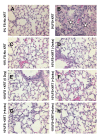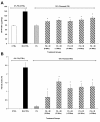Dietary flaxseed administered post thoracic radiation treatment improves survival and mitigates radiation-induced pneumonopathy in mice
- PMID: 21702963
- PMCID: PMC3146937
- DOI: 10.1186/1471-2407-11-269
Dietary flaxseed administered post thoracic radiation treatment improves survival and mitigates radiation-induced pneumonopathy in mice
Abstract
Background: Flaxseed (FS) is a dietary supplement known for its antioxidant and anti-inflammatory properties. Radiation exposure of lung tissues occurs either when given therapeutically to treat intrathoracic malignancies or incidentally, such as in the case of exposure from inhaled radioisotopes released after the detonation of a radiological dispersion devise (RDD). Such exposure is associated with pulmonary inflammation, oxidative tissue damage and irreversible lung fibrosis. We previously reported that dietary FS prevents pneumonopathy in a rodent model of thoracic X-ray radiation therapy (XRT). However, flaxseed's therapeutic usefulness in mitigating radiation effects post-exposure has never been evaluated.
Methods: We evaluated the effects of a 10%FS or isocaloric control diet given to mice (C57/BL6) in 2 separate experiments (n = 15-25 mice/group) on 0, 2, 4, 6 weeks post a single dose 13.5 Gy thoracic XRT and compared it to an established radiation-protective diet given preventively, starting at 3 weeks prior to XRT. Lungs were evaluated four months post-XRT for blood oxygenation levels, inflammation and fibrosis.
Results: Irradiated mice fed a 0%FS diet had a 4-month survival rate of 40% as compared to 70-88% survival in irradiated FS-fed mouse groups. Additionally, all irradiated FS-fed mice had decreased fibrosis compared to those fed 0%FS. Lung OH-Proline content ranged from 96.5 ± 7.1 to 110.2 ± 7.7 μg/ml (Mean ± SEM) in all irradiated FS-fed mouse groups, as compared to 138 ± 10.8 μg/ml for mice on 0%FS. Concomitantly, bronchoalveolar lavage (BAL) protein and weight loss associated with radiation cachexia was significantly decreased in all FS-fed groups. Inflammatory cell influx to lungs also decreased significantly except when FS diet was delayed by 4 and 6 weeks post XRT. All FS-fed mice (irradiated or not), maintained a higher blood oxygenation level as compared to mice on 0%FS. Similarly, multiplex cytokine analysis in the BAL fluid revealed a significant decrease of specific inflammatory cytokines in FS-fed mice.
Conclusions: Dietary FS given post-XRT mitigates radiation effects by decreasing pulmonary fibrosis, inflammation, cytokine secretion and lung damage while enhancing mouse survival. Dietary supplementation of FS may be a useful adjuvant treatment mitigating adverse effects of radiation in individuals exposed to inhaled radioisotopes or incidental radiation.
Figures









Similar articles
-
Radiation mitigating properties of the lignan component in flaxseed.BMC Cancer. 2013 Apr 4;13:179. doi: 10.1186/1471-2407-13-179. BMC Cancer. 2013. PMID: 23557217 Free PMC article.
-
Dietary flaxseed prevents radiation-induced oxidative lung damage, inflammation and fibrosis in a mouse model of thoracic radiation injury.Cancer Biol Ther. 2009 Jan;8(1):47-53. doi: 10.4161/cbt.8.1.7092. Epub 2009 Jan 1. Cancer Biol Ther. 2009. PMID: 18981722 Free PMC article.
-
Radioprotective role in lung of the flaxseed lignan complex enriched in the phenolic secoisolariciresinol diglucoside (SDG).Radiat Res. 2012 Dec;178(6):568-80. doi: 10.1667/RR2980.1. Epub 2012 Oct 29. Radiat Res. 2012. PMID: 23106213 Free PMC article.
-
Plant extracts and plant-derived compounds: promising players in a countermeasure strategy against radiological exposure.Asian Pac J Cancer Prev. 2014;15(6):2405-25. doi: 10.7314/apjcp.2014.15.6.2405. Asian Pac J Cancer Prev. 2014. PMID: 24761841 Review.
-
Radiation and the lung: a reevaluation of the mechanisms mediating pulmonary injury.Int J Radiat Oncol Biol Phys. 1995 Jan 15;31(2):361-9. doi: 10.1016/0360-3016(94)00477-3. Int J Radiat Oncol Biol Phys. 1995. PMID: 7836090 Review.
Cited by
-
Flaxseed lignans enriched in secoisolariciresinol diglucoside prevent acute asbestos-induced peritoneal inflammation in mice.Carcinogenesis. 2016 Feb;37(2):177-87. doi: 10.1093/carcin/bgv174. Epub 2015 Dec 17. Carcinogenesis. 2016. PMID: 26678224 Free PMC article.
-
Novel synthetic (S,S) and (R,R)-secoisolariciresinol diglucosides (SDGs) protect naked plasmid and genomic DNA From gamma radiation damage.Radiat Res. 2014 Jul;182(1):102-10. doi: 10.1667/RR13635.1. Epub 2014 Jun 19. Radiat Res. 2014. PMID: 24945894 Free PMC article.
-
Inter-agency perspective: Translating advances in biomarker discovery and medical countermeasures development between terrestrial and space radiation environments.Life Sci Space Res (Amst). 2022 Nov;35:9-19. doi: 10.1016/j.lssr.2022.06.004. Epub 2022 Jun 14. Life Sci Space Res (Amst). 2022. PMID: 36336375 Free PMC article.
-
Radiation mitigating properties of the lignan component in flaxseed.BMC Cancer. 2013 Apr 4;13:179. doi: 10.1186/1471-2407-13-179. BMC Cancer. 2013. PMID: 23557217 Free PMC article.
-
Asbestos Induces Oxidative Stress and Activation of Nrf2 Signaling in Murine Macrophages: Chemopreventive Role of the Synthetic Lignan Secoisolariciresinol Diglucoside (LGM2605).Int J Mol Sci. 2016 Mar 1;17(3):322. doi: 10.3390/ijms17030322. Int J Mol Sci. 2016. PMID: 26938529 Free PMC article.
References
-
- Chin FK. Scenario of a dirty bomb in an urban environment and acute management of radiation poisoning and injuries. Singapore Med J. 2007;48(10):950–957. - PubMed
Publication types
MeSH terms
Substances
Grants and funding
LinkOut - more resources
Full Text Sources
Other Literature Sources
Medical

